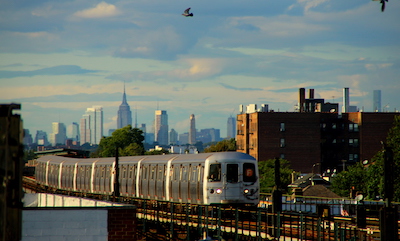Who Can Stay Home in a Pandemic?
 New York City has been the epicenter of America’s COVID-19 epidemic, with over 200,000 confirmed cases and over 16,000 deaths to date. New York City Mayor Bill de Blasio issued stay-at-home guidance on March 22, following a New York State executive order, and both were extended for the Five Boroughs at the end of May as the city continues to see high rates of infection.
New York City has been the epicenter of America’s COVID-19 epidemic, with over 200,000 confirmed cases and over 16,000 deaths to date. New York City Mayor Bill de Blasio issued stay-at-home guidance on March 22, following a New York State executive order, and both were extended for the Five Boroughs at the end of May as the city continues to see high rates of infection.
But the ability to stay home has not been equal, as illustrated by a new School of Public Health study based on NYC subway ridership data.
Available in preprint on medRxiv ahead of peer-reviewed publication, the study shows that the same neighborhoods had higher subway ridership and coronavirus infections: communities of color and lower-income communities. In their analysis, the researchers found that the high numbers of essential workers in these communities is the main factor in these disparities.
The researchers also found that NYC boroughs that reduced subway ridership earlier saw COVID-19 cases plateau sooner, but with an approximately 28-day lag.
Both findings have important implications for policymakers in NYC and around the country, says study lead author Reese Sy, a doctoral student and graduate research fellow in the Department of Epidemiology.
“If a resurgence occurs and measures are reinstated, we would expect a lag of approximately a month in densely populated cities before cases plateau,” Sy says.
At the same time, “more needs to be done to address sociodemographic and health disparities during the pandemic: In New York City, the largest hotspot of COVID-19 in the United States, the ability to stay home and appropriately social distance during the pandemic has been constrained by socioeconomic status and the need to engage in essential work,” Sy says.
“What this demonstrates is that being able to stay home and socially distance is a privilege with a price tag,” says Laura White, associate professor of biostatistics and the study’s senior author. “This seems to have clear trickle down implications for the risk of disease.”
Sy, White, and colleagues used zip code tabulation area-level and borough-level demographic data and COVID-19 case data as of April 26, and subway swipe data from January 4 to April 11, for Manhattan, Brooklyn, Queens, and the Bronx (Staten Island was not included because it does not have subway connections to other boroughs).
The researchers found that New Yorkers were taking the subway 69.7 percent less than normal by April 11, but changes in subway ridership varied widely. The Bushwick/Bedford-Stuyvesant neighborhood in Brooklyn had the greatest reduction in subway use, followed by Manhattan’s Upper West Side, while the areas with the least reductions in subway use were Rockway, Queens, and Fort George, Manhattan. By borough, Manhattan had the greatest and earliest decline in subway ridership, followed by Brooklyn, then Queens, and finally the Bronx.
The researchers found that more subway use was associated with higher COVID-19 case rates after adjusting for how much testing was done in those areas. However, the association between subway ridership and COVID-19 cases was weaker when the researchers adjusted for median income, suggesting that continued mobility during the city’s epidemic has been especially dangerous for lower-income New Yorkers.
The boroughs saw the end of the exponential growth of COVID-19 cases in the same order that subway ridership dropped off: Manhattan’s cases plateaued first, followed by Brooklyn, Queens, and the Bronx.
The researchers found that areas with lower median income, a greater percentage of individuals who identify as non-white and/or Hispanic/Latino, a greater percentage of essential workers, and a greater percentage of healthcare workers had more subway use during the pandemic. When the researchers adjusted for the percentage of essential workers living in an area, the associations between subway use and income and between subway use and race/ethnicity disappeared.
In other words, Sy says, “Disparities in mobility reductions are driven by necessity, and there is reduced ability to shelter-in-place among these marginalized communities.”
The study was co-authored by Benjamin Rader, a graduate research fellow and doctoral student in the Department of Epidemiology, and Micaela E. Martinez of the Columbia University Mailman School of Public Health.